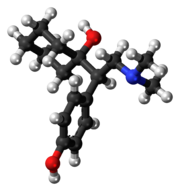 | |
 | |
| Clinical data | |
|---|---|
| Trade names | Pristiq, Desfax, Ellefore, others |
| Other names | O-desmethylvenlafaxine, WY-45233 |
| AHFS/Drugs.com | Monograph |
| MedlinePlus | a608022 |
| License data | |
| Pregnancy category |
|
| Routes of administration | By mouth |
| ATC code | |
| Legal status | |
| Legal status | |
| Pharmacokinetic data | |
| Bioavailability | 80% |
| Protein binding | Low (30%) |
| Metabolism | CYP2C19,[4] CYP3A4, (CYP2D6 is not involved) |
| Elimination half-life | 11 h |
| Excretion | 45% excreted unchanged in urine |
| Identifiers | |
| |
| CAS Number | |
| PubChem CID | |
| IUPHAR/BPS | |
| DrugBank | |
| ChemSpider | |
| UNII | |
| KEGG | |
| ChEBI | |
| ChEMBL | |
| CompTox Dashboard (EPA) | |
| ECHA InfoCard | 100.149.615 |
| Chemical and physical data | |
| Formula | C16H25NO2 |
| Molar mass | 263.381 g·mol−1 |
| 3D model (JSmol) | |
| |
| |
| | |
Desvenlafaxine, sold under the brand name Pristiq among others, is a medication used to treat depression.[5] It is an antidepressant of the serotonin-norepinephrine reuptake inhibitor (SNRI) class and is taken by mouth.[5] It is recommended that the need for further treatment be occasionally reassessed.[5] It may be less effective than its parent compound venlafaxine,[6] although some studies have found comparable efficacy.[7]
Common side effects include dizziness, trouble sleeping, increased sweating, constipation, sleepiness, anxiety, and sexual problems.[5] Serious side effects may include suicide in those under the age of 25, serotonin syndrome, bleeding, mania, and high blood pressure.[5] There is a high risk of withdrawal syndrome which may occur if the dose is decreased or the medication is completely stopped.[5][8] It is unclear if use during pregnancy or breastfeeding is safe.[9]
Desvenlafaxine was approved for medical use in the United States in 2008.[5] In Europe its application for use was denied in 2009.[6] In 2022, it was the 208th most commonly prescribed medication in the United States, with more than 1 million prescriptions.[10][11]
- ^ "FDA-sourced list of all drugs with black box warnings (Use Download Full Results and View Query links.)". nctr-crs.fda.gov. FDA. Retrieved 22 Oct 2023.
- ^ Anvisa (2023-03-31). "RDC Nº 784 - Listas de Substâncias Entorpecentes, Psicotrópicas, Precursoras e Outras sob Controle Especial" [Collegiate Board Resolution No. 784 - Lists of Narcotic, Psychotropic, Precursor, and Other Substances under Special Control] (in Brazilian Portuguese). Diário Oficial da União (published 2023-04-04). Archived from the original on 2023-08-03. Retrieved 2023-08-16.
- ^ "Mental health". Health Canada. 9 May 2018. Retrieved 13 April 2024.
- ^ "Desvenlafaxine Metabolic pathways". SMPBD. Retrieved February 3, 2022.
- ^ a b c d e f g "Desvenlafaxine Succinate Monograph for Professionals". Drugs.com. American Society of Health-System Pharmacists. Retrieved 18 March 2019.
- ^ a b "Withdrawal Assessment Report for Dessvenlafaxime" (PDF). EMA. p. 3. Retrieved 22 March 2019.
- ^ Cite error: The named reference
:0was invoked but never defined (see the help page). - ^ Miller K, King LM (10 July 2024). Begum J (ed.). "Withdrawal From Antidepressants: Symptoms, Causes, Treatments". WebMD. Retrieved 2024-09-02.
- ^ "Desvenlafaxine Pregnancy and Breastfeeding Warnings". Drugs.com. Retrieved 19 March 2019.
- ^ "The Top 300 of 2022". ClinCalc. Archived from the original on 30 August 2024. Retrieved 30 August 2024.
- ^ "Desvenlafaxine Drug Usage Statistics, United States, 2013 - 2022". ClinCalc. Retrieved 30 August 2024.